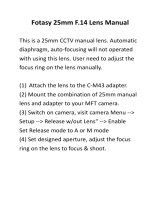
An extension tube is an exceptionally useful tool for macro photography that enables you to convert
almost any lens into a macro lens with very close focusing economically while maintaining the optical
quality of your lens.
ProMaster extension tubes have no optics. They are mounted between the camera body and lens
creating more distance between the lens and film plane. By moving the lens farther away from the film or
CCD sensor in the camera, the lens focuses much closer allowing greater magnification of your subject.
The greater the length of the extension tube, the closer the lens can focus.
ProMaster Automatic Extension Tubes couple with your camera's automatic diaphragm. Your camera will
properly calculate the exposure in the TTL or AE modes with natural light. Automatic Flash TTL exposure
does not function properly with an extension tube in place.
ProMaster Automatic Extension Tubes are available as a set (12mm, 20mm, and 36mm), or as individual
tubes in 12mm, 20mm, 25mm, and 36mm in mounts to fit Canon EF/EFS, Nikon F, and Sony A.
OPERATING INSTRUCTIONS
Attaching to your camera
The extension tube attaches to your camera in the same manner as your lens. Match the indicator mark
on the tube to the indicator mark on your camera and rotate until it locks.
To insure proper meter coupling, always mount the tube(s) on your camera first, then mount the lens onto
the tube(s).
Combining tubes
When using more than one extension tube, attach the tubes together in any order, then mount to your
camera body.
Lens compatibility
The best results will be obtained when using standard to semi-telephoto focal lengths or with a macro lens.
Wide-angle and zoom lenses may be used, but depending on how the lens is combined with the tube the
distance between front of the lens and subject may become extremely close.
Using with TTL AE modes
If the extension tube is correctly attached, it not only couples with the automatic diaphragm but also with
TTL meter and AE (EE) mechanism. The exposure will be automatically calculated and you can shoot
normally following the camera manufacturer’s directions.
Using in non TTL mode
Exposure will need to be calculated manually observing the additional exposure factor added by the
length of the tube.












